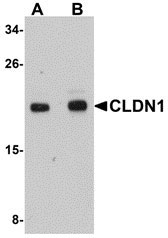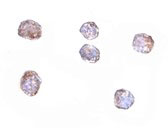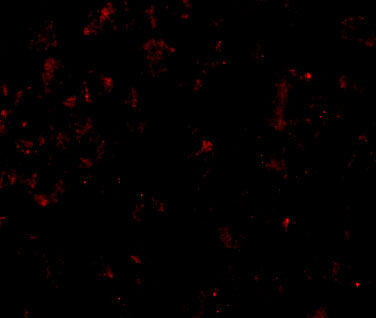CLDN1 Antibody
- 产品详情
- 实验流程
- 背景知识
Application
| WB, IF, ICC, E |
|---|---|
| Primary Accession | O95832 |
| Other Accession | CAG33419, 48146393 |
| Reactivity | Human, Mouse, Rat |
| Host | Rabbit |
| Clonality | Polyclonal |
| Isotype | IgG |
| Calculated MW | 22744 Da |
| Concentration (mg/ml) | 1 mg/mL |
| Conjugate | Unconjugated |
| Application Notes | CLDN1 antibody can be used for detection of CLDN1 by Western blot at 1 - 2 µg/mL. Antibody can also be used for immunocytochemistry starting at 5 µg/mL. For immunofluorescence start at 20 µg/mL. |
| Gene ID | 9076 |
|---|---|
| Other Names | Claudin-1, Senescence-associated epithelial membrane protein, CLDN1, CLD1, SEMP1 |
| Target/Specificity | CLDN1; |
| Reconstitution & Storage | CLDN1 antibody can be stored at 4℃ for three months and -20℃, stable for up to one year. As with all antibodies care should be taken to avoid repeated freeze thaw cycles. Antibodies should not be exposed to prolonged high temperatures. |
| Precautions | CLDN1 Antibody is for research use only and not for use in diagnostic or therapeutic procedures. |
| Name | CLDN1 |
|---|---|
| Synonyms | CLD1, SEMP1 |
| Function | Claudins function as major constituents of the tight junction complexes that regulate the permeability of epithelia. While some claudin family members play essential roles in the formation of impermeable barriers, others mediate the permeability to ions and small molecules. Often, several claudin family members are coexpressed and interact with each other, and this determines the overall permeability. CLDN1 is required to prevent the paracellular diffusion of small molecules through tight junctions in the epidermis and is required for the normal barrier function of the skin. Required for normal water homeostasis and to prevent excessive water loss through the skin, probably via an indirect effect on the expression levels of other proteins, since CLDN1 itself seems to be dispensable for water barrier formation in keratinocyte tight junctions (PubMed:23407391). |
| Cellular Location | Cell junction, tight junction. Cell membrane; Multi-pass membrane protein. Basolateral cell membrane Note=Associates with CD81 and the CLDN1-CD81 complex localizes to the basolateral cell membrane. |
| Tissue Location | Strongly expressed in liver and kidney. Expressed in heart, brain, spleen, lung and testis. |
For Research Use Only. Not For Use In Diagnostic Procedures.
Provided below are standard protocols that you may find useful for product applications.
BACKGROUND
CLDN1 Antibody: Claudin1 (CLDN1), a member of the claudin family, is an integral membrane protein and a component of tight junction strands. Tight junctions are specialized regions of cell to cell contact consisting of networking strands that act as a molecular gasket for preventing the leakage of ions, water, etc., between cells. They are abundant in luminal epithelial sheets where they maintain epithelial cell polarity. Different tissues exhibit different Claudin composition and CLDN1 expression is often cell type and tissue dependent. Loss of function mutations result in neonatal ichthyosis-sclerosing cholangitis syndrome. CLDN1 and CLDN2 were found to be overexpressed in colonal cancer tissues and may be useful as tumor markers and targets for the treatment of colorectal cancer. Characterization of Claudins expression in human tumors can be an additional diagnostic tool. Recent studies show that CLDN1 has gastric tumor suppressive activity and is a direct transcriptional target of RUNX3. Along with SCARB1, LDL-R, and the tetraspanin superfamily member CD81, CLDN1 has been reported to be an entry factor for the Hepatitis C virus.
REFERENCES
Tepass U. Claudin complexities at the apical junctional complex. Nat. Cell Biol.2003; 5:595-7.
Kinugasa T, Huo Q, Higashi D, et al. Selective up-regulation of claudin-1 and claudin-2 in colorectal cancer. Anticancer Res.2007; 27:3729-34.
Paschoud S, Bongiovanni M, Pache JC, et al. Claudin-1 and claudin-5 expression patterns differentiate lung squamous cell carcinomas from adenocarcinomas. Mod. Pathol.2007; 20:947-954.
Morohashi S, Kasumi T, Sato F, et al. Decreased expression of claudin-1 correlates with recurrence status in breast cancer. Int. J. Mol. Med.2007; 20:139-43.
终于等到您。ABCEPTA(百远生物)抗体产品。
点击下方“我要评价 ”按钮提交您的反馈信息,您的反馈和评价是我们最宝贵的财富之一,
我们将在1-3个工作日内处理您的反馈信息。
如有疑问,联系:0512-88856768 tech-china@abcepta.com.























 癌症的基本特征包括细胞增殖、血管生成、迁移、凋亡逃避机制和细胞永生等。找到癌症发生过程中这些通路的关键标记物和对应的抗体用于检测至关重要。
癌症的基本特征包括细胞增殖、血管生成、迁移、凋亡逃避机制和细胞永生等。找到癌症发生过程中这些通路的关键标记物和对应的抗体用于检测至关重要。 为您推荐一个泛素化位点预测神器——泛素化分析工具,可以为您的蛋白的泛素化位点作出预测和评分。
为您推荐一个泛素化位点预测神器——泛素化分析工具,可以为您的蛋白的泛素化位点作出预测和评分。 细胞自噬受体图形绘图工具为你的蛋白的细胞受体结合位点作出预测和评分,识别结合到自噬通路中的蛋白是非常重要的,便于让我们理解自噬在正常生理、病理过程中的作用,如发育、细胞分化、神经退化性疾病、压力条件下、感染和癌症。
细胞自噬受体图形绘图工具为你的蛋白的细胞受体结合位点作出预测和评分,识别结合到自噬通路中的蛋白是非常重要的,便于让我们理解自噬在正常生理、病理过程中的作用,如发育、细胞分化、神经退化性疾病、压力条件下、感染和癌症。








